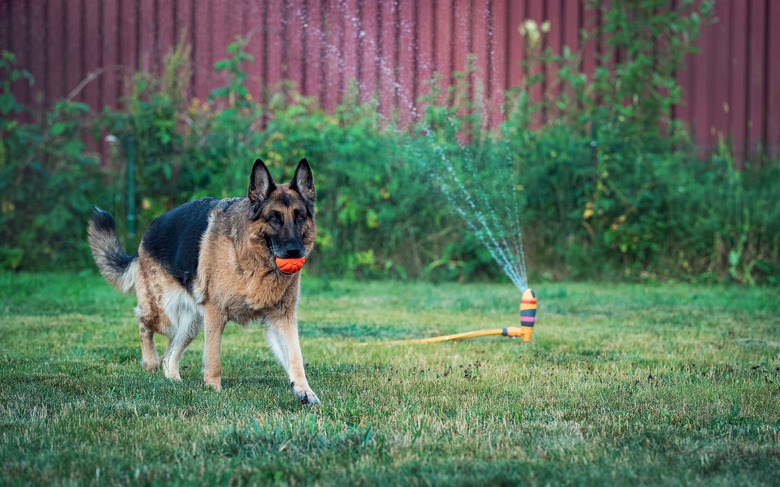How Common Is A Collapsed Trachea In Puppies?
A puppy's trachea, commonly called a windpipe, is essential for carrying air to their lungs. We spoke with Dr. Ingrid Taylor, a veterinarian with 16 years of experience in general clinical and emergency practice and public health, to talk about understanding signs of collapsed trachea. Knowing your dog's risk level (for instance, tracheal collapse in dogs is rarely found in large breeds) and the signs can help your pup get swift veterinary treatment if needed.
Tracheal collapse in dogs
Tracheal collapse in dogs
Tracheal collapse occurs almost exclusively in small breed dogs. "Collapsing trachea is most common in middle-aged to older toy, miniature, and small-breed dogs, such as Pomeranians, poodles, and Chihuahuas," says Dr. Taylor. "Medium- and large-breed dogs can also be affected by a similar condition known as bronchomalacia, a collapse that affects the bronchi, or large airway passages that bring air from the trachea to the lungs."
A puppy's trachea is held open by a series of C-shaped rings of cartilage. If these rings of cartilage are weak, misshapen, or begin to soften, the trachea will start to close, leading to respiratory distress. When this happens, the puppy will have difficulty getting enough oxygen through the windpipe. The severity of the problem depends on how much the trachea has collapsed.
Some symptoms of tracheal collapse include respiratory distress, including a dog coughing when excited, eating, drinking, or pulling on a leash. This cough might be dry, harsh, or honking. "Other signs to look for include a rapid respiratory rate, an inability to exercise or becoming distressed, and showing respiratory difficulty while exercising," explains Dr. Taylor. "Difficulty breathing brought on by physical stress, heat, or humidity; and a chronic cough that may include wheezing are also signs."
Remember that respiratory distress is an emergency. Dogs in distress should be seen by a veterinarian right away.
Collapsing trachea in toy breeds of dogs
Collapsing trachea in toy breeds of dogs
Collapsing trachea in dogs is far more common in certain toy breeds; in puppies, it is usually congenital. Breeds most susceptible include the Yorkshire terrier, Pomeranian, Chihuahua, Maltese, Shih Tzu, pug, and toy poodle. Many affected dogs will often start showing symptoms around 1 year of age, with some early signs presenting around 6 months of age.
Trachea problems in dogs are more likely to manifest in toy breeds, so be sure to keep an ear out for the collapsing trachea sound of a dry cough, particularly when a dog is excited or exercising.
Bronchomalacia in medium- and large-breed dogs
Bronchomalacia in medium- and large-breed dogs
While tracheal collapse occurs almost exclusively in small-breed dogs, large-breed dogs can suffer from bronchomalacia, a condition which can also affect the airway. Bronchomalacia most often occurs in older, overweight dogs of any breed, and side effects may include gagging, rapid breathing, and blockage of the airway.
Causes, diagnosis, and treatment for a dog's collapsed trachea
Causes, diagnosis, and treatment for a dog's collapsed trachea
In puppies, the cause of a collapsed trachea is unknown but is commonly associated with weakness and flattening of the tracheal rings in small-breed dogs. It is possible that secondary factors, such as inflammation, cause the disease to worsen over time. Some health conditions, like congestive heart failure, obesity, or chronic bronchitis can contribute to a collapsed trachea. These conditions are unlikely in puppies, however, since they are generally problems found in older dogs that affect the trachea over time.
Radiographs, or X-rays, may be used to diagnose tracheal collapse. While in severe cases a tracheal collapse can be life threatening, dog health can be improved by medical management. "Medical management of a collapsing trachea may include weight loss, using harnesses instead of leashes, anti-inflammatory medications, cough suppressants, and other medications," explains Dr. Taylor. "Surgery may also be recommended in severe cases." Dr. Taylor also stresses how fast breathing problems can become an emergency and says it is very important to avoid overheating in dogs with tracheal collapse and/or bronchomalacia.
The bottom line
The bottom line
Tracheal collapse in dogs rarely manifests before 6 months of age and is most common in toy breeds. Signs include a honking cough, difficulty breathing, and a rapid respiratory rate. Dogs of any breed can suffer from a similar condition known as bronchomalacia, a collapse that affects the bronchi. Bronchomalacia is most common in overweight, older dogs and can be especially common in breeds with flattened faces, like pugs. Large-breed dogs rarely suffer from tracheal collapse.
"It's very important to note that dogs experiencing tracheal collapse or bronchomalacia should not be allowed to overheat, as it can exacerbate breathing problems," says Dr. Taylor. Remember that respiratory distress is an emergency. Consult your veterinarian as soon as possible if you notice that your dog is in distress.


